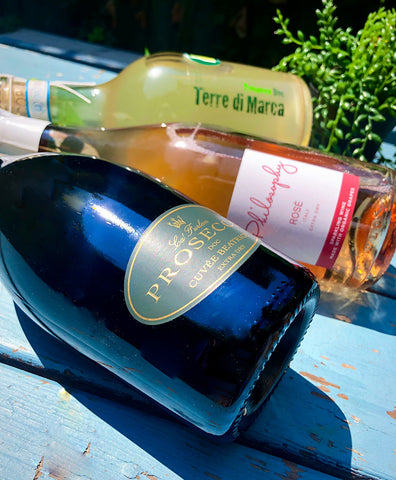NATIONAL PROSECCO DAY! PROSECCO 101
In honor of National Prosecco Day we’re schooling you on everyone’s favorite brunch-approved bubbly. From bottomless brunches to impromptu celebrations, fine dining aperitifs, wedding toasts, and the after after party, few things pair as seamlessly with any occasion as Prosecco. With late summer festivities on the horizon, now’s the perfect time to take a closer look at this all-around perfect party sipper.

ANYTHING BUT NEW, ANYTHING BUT CHAMPAGNE
First and foremost, Prosecco is not Champagne. Champagne can only be made in the French winemaking region called, well...Champagne. While Champagne can be made from Chardonnay, Pinot Noir, Pinot Meunier, Pinot Blanc, and even Pinot Gris, Prosecco can only be made using at least 85% Glera grapes. Glera is an excellent grape for sparkling wines, with high yields, moderate acidity and aromas of melon, peach, and white flowers. More recently, Prosecco Rosé was ratified by Italian and EU authorities, which allows for a mixture of Glera and Pinot Noir.
One of the earliest known mentions of this classic Italian wine is by an Englishman named Fynes Moryson who visited northern Italy in the 1590s, but even then “Prosecho,” Moryson wrote, was known as one of the country’s most famous wines.
TERROIR
Prosecco hails from nine provinces in the Veneto and Friuli-Venezia Giulia in Northeastern Italy. Glera has been grown in these regions for hundreds of years making it a substantial part of the local history.
METHOD
Most Prosecco is produced using the Charmat or tank method. In this method, base wine, after its initial post-harvest fermentation, is placed into a high pressure tank, where a second dose of sugar and yeast is added to trigger a second fermentation -- this is all about getting bubbles into the finished wine. The bubbles are closely monitored as they form, and when they get to the desired level, the tank is cooled, slowing, then stopping the rapid fermentation. This method helps to preserve the freshness and flavor of Glera in the finished wine. Note, we said “most Prosecco,” but more on that later.
THREE STYLES TO EXPLORE
Ca’ Furlan Prosecco Cuvee Beatrice: This is one of our favorites, boasting a beautiful nose reminiscent of marzipan and white flowers, the wine leads into peach notes and brioche on the palate. A fantastic value for a sparkling wine.
Corvezza Terre di Marca Prosecco NV: The Corvezzo family winery is located in the heart of Treviso's countryside, which is celebrated as much for its culture as its beauty. Here they produce Prosecco col fondo, a super traditional production method that predates the Charmat method. In this style the wine undergoes its second, bubble-inducing fermentation in the bottle, and the spent yeast is allowed to remain at the bottom of the bottle, sort of like a pet-nat. This method creates a wine with all the fresh flavor of Prosecco, with some added funk and texture. Made exclusively from organic grapes, this bubbly opens with scents of apple and pear blossoms and glides along the palate with a silky, tongue-tickling texture. Balanced acidity and a long finish makes this wine a great partner for seafood, pizza, and salty snacks.
Philosophy Sparkling Rosé NV: Easygoing organic Italian Prosecco rosé with notes of apple, apricot, and cherry blossom help make this refreshing bubbly perfect for any occasion. Pair with spicy foods or festive weekend afternoons with friends. The choice is yours! Vegan.

